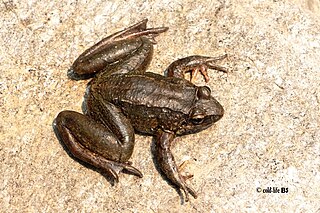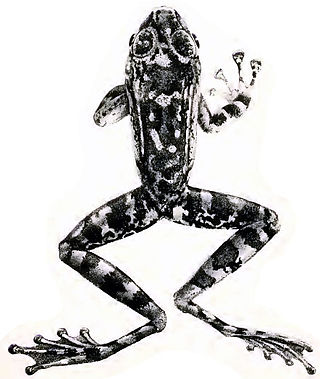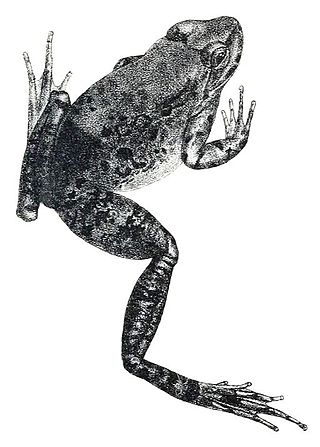Amolops chakrataensis, also known as the Dehradun stream frog or Chakrata torrent frog, is a species of frog endemic to India. It is only known from its type locality near Chakrata in Uttarakhand, near the Tiger Falls. It was described based on a single specimen collected in 1985. After being "lost" for 25 years, the species was rediscovered in 2011 at its type locality, reflecting the lack of field work in the area.
Amolops himalayanus is a species of frog found in northeastern India and Nepal.
Amolops jaunsari, also known as the Jaunsar stream frog or Jaunsar's torrent frog, is a species of frog endemic to India. It is only known from its type locality near Chakrata in Uttarakhand. It was described based on a single specimen collected in 1985 and has not been recorded ever since.

Amolops marmoratus is a species of ranid frog found in Asia. Its common names include marbled sucker frog, marbled cascade frog, Pegu torrent frog, and many others. The taxonomic status of many populations formerly assigned to this species is uncertain.
Amolops monticola is a species of frog in the family Ranidae, the "true frogs". It is found in the Northeast India, eastern Nepal, and western China, although there is some uncertainty regarding the Chinese records. It probably also occurs in the intervening Bhutan. Common names mountain sucker frog, mountain stream frog, mountain torrent frog, and mountain cascade frog have been coined for it.

Ombrana is a monotypic genus of frogs in the family Dicroglossidae. It is represented by a single species, Ombrana sikimensis. The validity of this genus is currently considered uncertain.

Walkerana diplosticta, also known as the spotted leaping frog, Malabar Indian frog, rufous leaf-hopper frog, and Günther's frog, is a species of frog in the family Ranixalidae. It is endemic to the Western Ghats south of the Palghat Gap and only known with certainty from the states of Kerala and Tamil Nadu, India. Localities with confirmed records include the Kalakkad Mundanthurai Tiger Reserve.

Duttaphrynus himalayanus, also known as the Himalaya toad, Himalayan toad, Himalayan broad-skulled toad, and Günther's high altitude toad, is a species of toad that is widely distributed throughout the Himalayan mountains. The Yunnanese populations are sometimes considered a separate species, Duttaphrynus cyphosus.

Amolops cremnobatus is a species of frogs in the family Ranidae. It is found in north-central Laos and Vietnam. Its range might extend into Thailand. The specific name cremnobatus is derived from Greek kremnobates, meaning "frequenter of steep places", and refers to the steep waterfall from which the type series were collected. Common name Lao sucker frog has been coined for it.

Amolops larutensis is a species of frog in the family Ranidae that is found in the Malay Peninsula from southernmost Thailand to Malaysia; records further north probably represent A. panhai.
Amolops nepalicus is a species of frog in the family Ranidae. It is endemic to Nepal and is only known from two localities in the Sankhuwasabha District. Common names Nepal sucker frog and Nepal cascade frog have been proposed for it.

Amolops spinapectoralis is a species of frog in the family Ranidae, the "true frogs". It is at present only known from a few locations in central Vietnam—that is, it is endemic to Vietnam—but it is likely to be found more widely in the Vietnamese Central Highlands as well as in the adjacent southeastern Laos and northeastern Cambodia. The specific name spinapectoralis is derived from Latin spina for "thorn" and pectoralis for "of the breast" and refers to the pectoral spines in adult males. Common name spinyback torrent frog has been coined for it.
Amolops tuberodepressus is a species of frog in the family Ranidae. It is endemic to Yunnan, China and known from Wuliang and Ailao Mountains in Jingdong County. Once suspected to be synonym of Amolops mantzorum, its validity was confirmed with molecular methods in 2014.
Huia modiglianii is a species of frog in the family Ranidae. It is endemic to Sumatra (Indonesia). It was originally only known from two locations near Lake Toba, but is now known to be more widespread. The specific name modiglianii honors Elio Modigliani, an Italian anthropologist and zoologist who collected the holotype in 1891. Common name Modigliani's huia frog has been coined for this species. Morphological evidence suggests that it can hybridize with Huia sumatrana, but this needs confirmation using genetic data.
Amolops mengyangensis is a species of frog in the family Ranidae. It is known with certainty only from its type locality, the eponymous Mengyang in Xishuangbanna Dai Autonomous Prefecture, southern Yunnan province of China. However, if Amolops daorum is its junior synonym, distribution of Amolops mengyangensis would be considerably wider, including the vicinity of Sa Pa in northern Vietnam near the Chinese border, Hong Kong, and Houaphanh Province in eastern Laos, and presumably also including the intervening areas.
Meristogenys macrophthalmus is a species of frog in the family Ranidae. It is endemic to Sarawak in northern Borneo (Malaysia) and is only known from its type locality in the Bintulu District. The specific name macrophthalmus is derived from the Greek words macros (="large") and ophthalmos (="eye") and refers to the large eyes of this frog. Common names Matsui's Borneo frog, large-eyed torrent frog, and big-eyed torrent frog have been coined for it.
Meristogenys phaeomerus is a species of frog in the family Ranidae. It is endemic to Borneo and known from central Sarawak (Malaysia) and adjacent Kalimantan (Indonesia). The specific name phaeomerus is derived from the Greek phaios for "dusky" and meros for "thigh", in reference to the appearance of the rear of the thigh. Common names Kapit Borneo frog and Kapit torrent frog have been coined for it.

Nanorana blanfordii is a species of frog in the family Dicroglossidae. It is found in northeastern India, southern Tibet (China), and eastern Nepal, and likely in the adjacent western Bhutan. The specific name blanfordii honours William Thomas Blandford, a British geologist and zoologist.

Nanorana liebigii, also known as Sikkim paa frog, Liebig's paa frog, Liebig's frog, and spiny-armed frog, is a species of frog in the family Dicroglossidae. It is found in the Himalayas, specifically in Bhutan, southern Tibet (China), northern India, and Nepal. The specific name liebigii honours a certain "Dr von Liebig Jr.", likely referring to Justus von Liebig, German botanist and chemist.
Amolops daorum is a species of frog in the family Ranidae. It is known from its type locality in the vicinity of Sa Pa in northern Vietnam near the Chinese border, Hong Kong, and Houaphanh Province in eastern Laos; presumably it also occurs the intervening areas. The Hong Kong record is considered suspicious, however.










